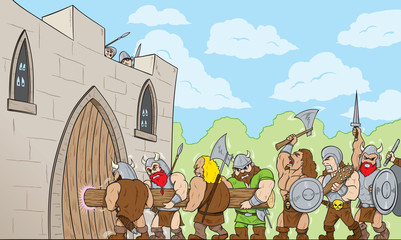I don’t think it will surprise anyone to hear that the unions are coming. They have been handed the mother of all issues to rally around. Covid-19 is going to be their poster child for organizing for years to come. Tragically, the onslaught has already begun. Union organizers and advocacy groups are already bragging about being “…busier in the last two months than [they’ve] ever been.” (Unions busy organizing)
You Can’t Win
If you were impacted by the pandemic, you must have responded in some way. Did you buy some protective gear, boost your sanitizer budget, layoff a bunch of people, shutter business for weeks? Whatever you did, the union will say you did it wrong.
- Bought some masks? You didn’t buy enough.
- Allowed people to work from home? You didn’t do it soon enough.
- Stayed open as long as possible to keep your staff employed? You put everyone’s life in danger.
You can’t win. No matter what you did, the union will find a way to make you the monster. And they will use your “monster” status to organize your employees. They will say to the employees:
- “If you’d had a union, we could’ve gotten you hazard pay,” or
- “If you had a union, we’d have made sure the employer provided more paid sick leave,” or
- “What’s going to happen next time? Who’s going to make sure there’s enough masks to go around? If you had a union, we’d fight for more PPE.”
For employees who are probably tense and anxious about the current situation, it’s pretty compelling stuff to hear from a beguiling union organizer. Your employees will start questioning whether you really do have their best interest in mind. They’ll start thinking, “Maybe I do need someone looking out for me?”
When the union organizer hands them a card to join, it will be a no-brainer.
Let me repeat that another way – they will sign the card, they will join the union. I’m not fearmongering, I’m telling you the truth. I know this from experience. I spent seven years working for the unions. I organized employees. I got them to sign cards. It was easy then; it would be simpler now. Remember what the union organizer said in the quote above, “[We’ve been] busier in the last two months than [we’ve] ever been.”
So, what can you do?
Communicate. Now. You must get out in front of this. You have to reach your employees before the unions do.
The unions will target two things:
- What did you do in response to the pandemic?
- What are you going to do in the future?
You need to get a communication to your employees discussing these two points.
Regarding what you did in response to the virus, I think you have a few things going for you that can help address the employees’ concerns and dampen the unions’ sales pitch…
- It was completely unexpected. No one saw this coming. Yes, I suppose the union could say that previous “events,” like Y2K and SARS should have prepared you for the current plague, but since everyone was caught off guard this time, and no one had a plan, their argument is weak. The virus came out of nowhere, spread tragically quick, and took all by surprise.
- Everyone was in the same boat. Everyone was hit by this at the same time and reacted in roughly the same way. Some of the timing issues were your decision, but most were driven by the government. Chances are you didn’t react any faster or slower than anyone else. A compelling timeline may help tell your story, e.g., “On January 15th, we created our Task Force to address the spread of Covid-19. On January 28th, we implemented our first response by issuing new policies on PPE. On March 1st, we implemented social distancing policies prior to the government’s mandate.”
- You did the best you could. Faced with a devasting event and unchartered waters, you simply did the best you could. As did everyone else, e.g., the government, your neighbors, your families. Everyone can second-guess behaviors, but in the heat of the moment you thought you were making the best decisions for employees, customers, patients, and families.
Those three responses should give you the overall theme to your response. However, to completely shut the door on the unions’ pitch, you must be able to address the details, like PPE, work-at-home policies, hazard pay, etc. You should spread the message out over several communications, delivered in different mediums. Group meetings with employees will be critical.
I looked at several union websites and labor-friendly blogs to anticipate “the attack.” Here’s a list of issues union organizers will be using against you (see below). If applicable, be sure to have a response to these issues in your communication:
- Lack of PPE. Why didn’t you have enough masks, gloves, sanitizer, Covid testing kits, etc…?
- Lack of hazard pay. Why didn’t you pay hazard pay? If you did, why didn’t you pay more?
- “Essential employee” status. A tangential issue to hazard pay will be defining your employees as “essential.” There is a feeling among employees who worked during the pandemic that they were “essential.” Some “essential” employees got hazard pay. Others did not. If you did not, your employees may ask, “Don’t you think we’re essential?”, implying that you should have given them hazard pay. You should have a kind and reasoned response. In some cases, “essential” was defined in Executive Orders. Lean on that and say, for example, “Yes, we do think you’re essential, and the government recognized that too, which allowed us to remain open, keep our employees employed, and serve our customers in this time of need.” It may not address the “hazard pay” issue, but it will show that you do believe they were and are essential.
- Lack of sick leave. Did you have sick leave, and if so, why didn’t you offer more? Some companies augmented their sick leave so employees could stay home during the “quarantine period,” e.g., an extra 80 hours of sick leave for self or family care. Did you?
- Low pay. The unions will hit this one hard. They will say if you paid your employees more, then taking time off to care for themselves or their families wouldn’t be a big deal. You will need to verify that your wages are competitive. If they’re not, and your employees aren’t organized, it may be time for a raise or a bonus…or both.
- Poor or no health insurance benefits. Are your benefits competitive? Are copays or deductibles inline with your competitors or other unionized companies? Can you provide a favorable example of how an employee would have fared if they were hospitalized during the pandemic?
- Putting profits over people. This will come up in several ways. Why didn’t you immediately shut down? Why did you put your employees and the public at risk by staying open? Why didn’t you spend money on enhanced protective devices, like plastic shields and dividers? A compassionate answer will stamp out rumors that you put money before people.
- No Emergency Fund. Certainly, an outlier issue, but the unions are raising it. Unions are out there saying, “Your company didn’t give you “relief money,” the government did, because your company doesn’t care about you.” Some companies did create emergency funds for their employees. If you didn’t, why not? There’s a good chance this issue may not come up, but if it does it would be a good to answer in a thoughtful, cogent manner.
Responses to these questions will help thwart the union attacks on “what you did.” However, you still have to address “what you’re going to do.” 
In looking at the unions’ websites, they are already stoking those anxieties. They’re saying it will be “business as usual” once this is all over and when it happens again, who’s going to be there for them?
You don’t need to address future plans – as in “the next pandemic” – in your first communication, but it should show up in your second message. At a minimum, you should address the following:
- What are you doing to plan for the next pandemic?
- How will you keep your employees safe?
- Are you stocking supplies like masks and gloves?
- Will you offer enhanced sick leave or time off?
- Can we work from home?
- How will you handle a closure?
- Are you going to have a committee or task force? Will frontline employees be on the committee?
If you can provide responses to this short list of questions, you will suck the wind from the sails of most union organizers and give your employees a greater peace of mind.
Right now, your employees are very anxious. They want to know what you did and why? They want to know what you’re going to do and when? Don’t let the union be the one delivering the message. The unions’ explanation of “what you did and why” will not be flattering…and it may come with a union card.
Scott Allan, JD, is the founder of The Allan Labor Group and curator of Healthcarelaborlaw.com. He’s spent over 25 years representing healthcare employers in their labor relations activities. He has worked in the public and private sector, represented rural nursing homes, small town clinics, state healthcare facilities, standalone hospitals, multibillion-dollar healthcare systems, and everything in between. He also spent seven years on the “inside” working for unions.





